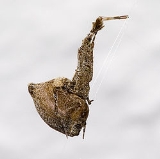
Hackled orb-weaver
Encyclopedia
Uloboridae, the cribellate orb weavers or hackled orb weavers, is a family
of non-venomous spider
s. Their lack of poison glands is a secondarily evolved trait. Instead, they kill their prey by crushing with over 140 metres of thread.
All members of this family produce a feathery, fuzzy silk
called cribellate (or hackled) silk. These spiders do not use an adhesive on their orb web
s, but rather the very fine fibers on each strand of silk tend to ensnare prey. Uloboridae webs often have a stabilimentum
or zig-zag pattern through the center.
There are only two species known from northern Europe: Uloborus walckenaerius
and Hyptiotes paradoxus.
Family (biology)
In biological classification, family is* a taxonomic rank. Other well-known ranks are life, domain, kingdom, phylum, class, order, genus, and species, with family fitting between order and genus. As for the other well-known ranks, there is the option of an immediately lower rank, indicated by the...
of non-venomous spider
Spider
Spiders are air-breathing arthropods that have eight legs, and chelicerae with fangs that inject venom. They are the largest order of arachnids and rank seventh in total species diversity among all other groups of organisms...
s. Their lack of poison glands is a secondarily evolved trait. Instead, they kill their prey by crushing with over 140 metres of thread.
All members of this family produce a feathery, fuzzy silk
Spider silk
Spider silk is a protein fiber spun by spiders. Spiders use their silk to make webs or other structures, which function as nets to catch other animals, or as nests or cocoons for protection for their offspring...
called cribellate (or hackled) silk. These spiders do not use an adhesive on their orb web
Spider web
A spider web, spiderweb, spider's web or cobweb is a device built by a spider out of proteinaceous spider silk extruded from its spinnerets....
s, but rather the very fine fibers on each strand of silk tend to ensnare prey. Uloboridae webs often have a stabilimentum
Web decorations
A web decoration or stabilimentum is a conspicuous silk structure included in the webs of some species of orb-web spider...
or zig-zag pattern through the center.
Distribution
This family has almost worldwide distribution.There are only two species known from northern Europe: Uloborus walckenaerius
Uloborus walckenaerius
Uloborus walckenaerius is a spider in the family Uloboridae.Females grow up to 6 mm, males up to 4 mm. It has a dark grey prosoma, covered with white hairs, leaving some dark bands uncovered. The spider lives in warm, open terrain, like heathland, and weaves horizontal cribellate webs...
and Hyptiotes paradoxus.
Genera
- Ariston O. P-CambridgeOctavius Pickard-CambridgeThe Reverend Octavius Pickard-Cambridge FRS was an English clergyman and zoologist.Pickard-Cambridge was born in Bloxworth rectory, Dorset, the fifth son of Revd George Pickard, rector and squire of Bloxworth: the family changed their name to Pickard-Cambridge in 1848...
, 1896 (Central America) - Astavakra Lehtinen, 1967 (Philippines)
- Conifaber Opell, 1982 (South America)
- Daramulunia Lehtinen, 1967 (Samoa, Fiji, New Hebrides)
- HyptiotesHyptiotes-Feeding:Hyptiotes creates a triangular web and sits at a vertex until it detects vibrations that signify the collision of its prey. At this moment hyptiotes releases a coil of silk which it has held taught in such a manner that the tension of the web causes it to entangle the spider's prey. The...
WalckenaerCharles Athanase WalckenaerBaron Charles Athanase Walckenaer was a French civil servant and scientist.-Biography:Walckenaer was born in Paris and studied at the universities of Oxford and Glasgow. In 1793 he was appointed head of the military transports in the Pyrenees, after which he pursued technical studies at the École...
, 1837 (Palearctic) - Lubinella Opell, 1984 (New Guinea)
- Miagrammopes O. P.-Cambridge, 1870 (America, Austrasia)
- Octonoba Opell, 1979 (Russia, Central Asia to Japan)
- Orinomana StrandEmbrik StrandEmbrik Strand was an arachnologist who classified many insect and spider species, including the greenbottle blue tarantula....
, 1934 (South America) - PhiloponellaPhiloponellaPhiloponella is a genus of uloborid spiders. Like all Uloboridae, these species have no venom.The species P. vicinus uses its silk to crush its victims to death.-Cooperation:...
Mello-LeitãoCândido Firmino de Mello-LeitãoCândido Firmino de Mello-Leitão, , was a Brazilian zoologist who is considered the founder of Arachnology in South America, publishing 198 papers on the taxonomy of Arachnida...
, 1917 (Africa, America, Asia, Australia) - Polenecia Lehtinen, 1967 (Mediterranean to Azerbaijan)
- Purumitra Lehtinen, 1967 (Australia, Philippines)
- Siratoba Opell, 1979 (USA, Mexico)
- SybotaSybotaSybota is a genus of Uloborid spiders. They are mostly found in the warmer regions of South America....
SimonEugène SimonEugène Simon was a French arachnologist. His many taxonomic contributions include categorizing and naming many spiders, as well as creating genera such as Anelosimus, Psellocoptus and Phlogius....
, 1892 (South America) - Tangaroa Lehtinen, 1967 (Oceania)
- UloborusUloborusUloborus is a spider genus in the family Uloboridae with 72 described species. Most species occur in the tropics and subtropics, with only few species in northern America and Europe....
LatreillePierre André LatreillePierre André Latreille was a French zoologist, specialising in arthropods. Having trained as a Roman Catholic priest before the French Revolution, Latreille was imprisoned, and only regained his freedom after recognising a rare species he found in the prison, Necrobia ruficollis...
, 1806 (worldwide) - Waitkera Opell, 1979 (New Zealand)
- Zosis Walckenaer, 1842 (Pantropical)

